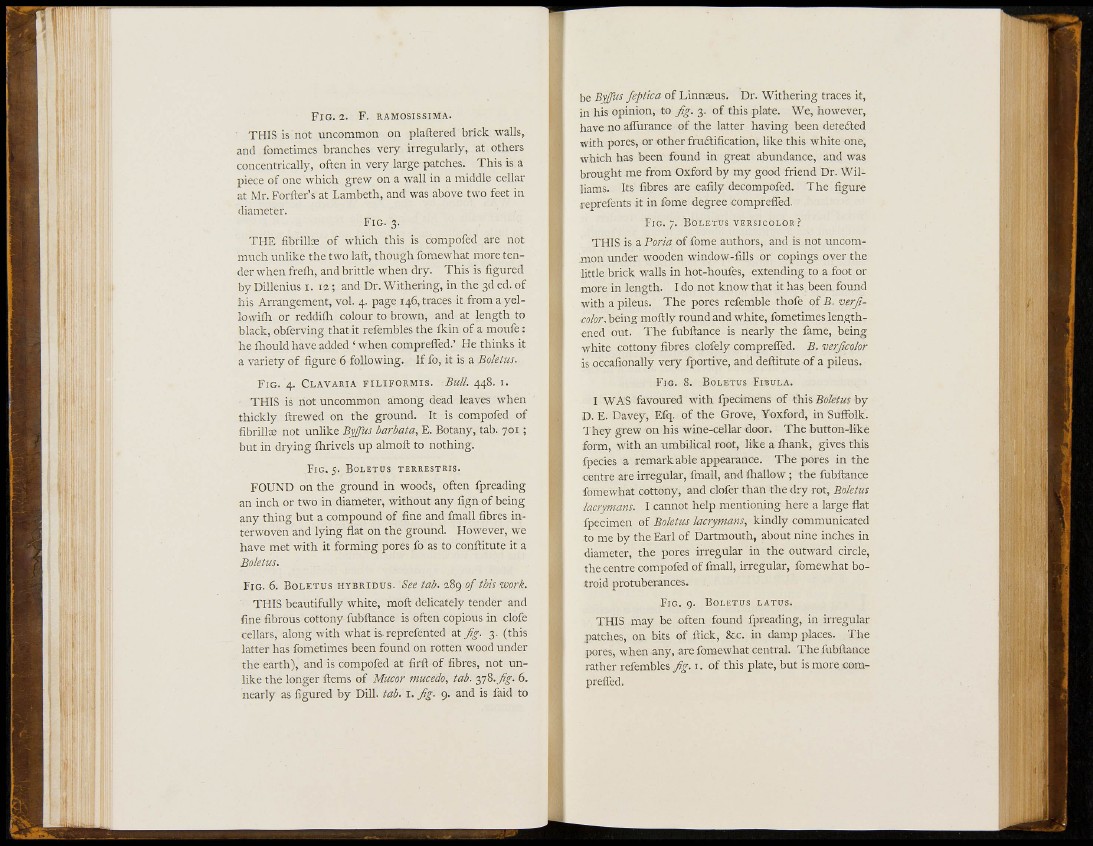
F I G . a. F. RAMOSISSIMA.
THIS is not uncommon on plaftered brick walls,
and fometimes branches very irregularly, at others
concentrically, often in very large patches. This is a
piece of one which grew on a wall in a middle cellar
at Mr. Forfter's at Lambeth, and was above two feet in
diameter.
F I G . 3.
THE fibrilla3 of which this is compofed are not
much unlike the two laft, though fomewhat more tender
when freili, and brittle when dry. This is figured
by Dillenius i. la; and Dr. Withering, in the 3d ed. of
his Arrangement, vol. 4. page 146, traces it fromayellowiili
or reddifli colour to brown, and at length to
black, obferving that it refembles the ikin of a moufe:
he ihould have added ' when compreffed.' He thinks it
a variety of figure 6 following. If fo, it is a Boletus.
F I G . 4. C L A V A H A FILIFORMIS. Bull. 448. i.
THIS is not uncommon among dead leaves when
thickly ftrewed on the ground. It is compofed of
fibrillx not unlike Byjus barbata, E. Botany, tab. 701;
but in drying ilirivels up almoft to nothing.
F I G . 5. BOLETUS TEREESTRIS.
FOUND on the ground in woods, often fpreading
an inch or two in diameter, without any fign of being
any thing but a compound of fine and fmall fibres interwoven
and lying flat on the ground. However, we
have met with it forming pores fo as to conftitute it a
Boletus.
F I G . 6. BOLETUS HYBRIDBS. See tab. 289 of this 'work.
THIS beautifully white, moft delicately tender and
fine fibrous cottony fubftance is often copious in clofe
cellars, along with what is. reprefented fig. 3- (this
latter has fometimes been found on rotten wood under
the earth), and is compofed at firft of fibres, not unlike
the longer ftems of Mucor mucedo, tab. 378.7%-. 6.
nearly as figured by Dill, tab, i. fig. 9. and is faid to
be ByffiíS feptica of Linnieus. Dr. Withering traces it,
in his opinion, to fig. 3. of this plate. We, however,
have no aflurance of the latter having been deíeóled
with pores, or other fruilification, like this white one,
which has been found in great abundance, and was
brought me from Oxford by my good friend Dr. Williams.
Its fibres are eafily decompofed. The figure
reprefents it in fome degree comprelfed.
FIG. 7. BOI.ETUS VERSICOLOR ?
THIS is a Poria of fome authors, and is not uncommon
under wooden window-fills or copings over the
little brick walls in hot-honfes, extending to a foot or
more in length. I do not know that it has been found
with a pileus. The pores refemble thofe of B. verficolor,
being moftly round and white, fometimes lengthened
out. The fubftance is nearly the fame, being
white cottony fibres clofely compreiTed. B. verficolor
is occafionally very fportive, and deftitute of a pileus.
F I G . 8. BOLETUS FIBULA.
I WAS favoured with fpecimens of this Boletus by
D. E. Davey, Efq. of the Grove, Yoxford, in Suffolk.
They grew on his wine-cellar door. The button-like
form, with an umbilical root, like a fliank, gives this
fpecies a remarkable appearance. The pores in the
centre are irregular, fmall, and fliallow ; the fubftance
fomewhat cottony, and clofer than the dry rot. Boletus
lacrymans. I cannot help mentioning here a large flat
fpecimen of Boletus lacrymans, kindly communicated
to me by the Earl of Dartmouth, about nine inches in
diameter, the pores irregular in the outward circle,
the centre compofed of fmall, irregular, fomewhat botroid
protuberances.
F I G . 9. BOLETUS LATUS.
THIS may be often found fpreading, in irregular
patches, on bits of ftick, &c. in damp places. The
pores, when any, are fomewhat central. The fubftance
rather refembles fig. i. of this plate, but is more compreiTed.